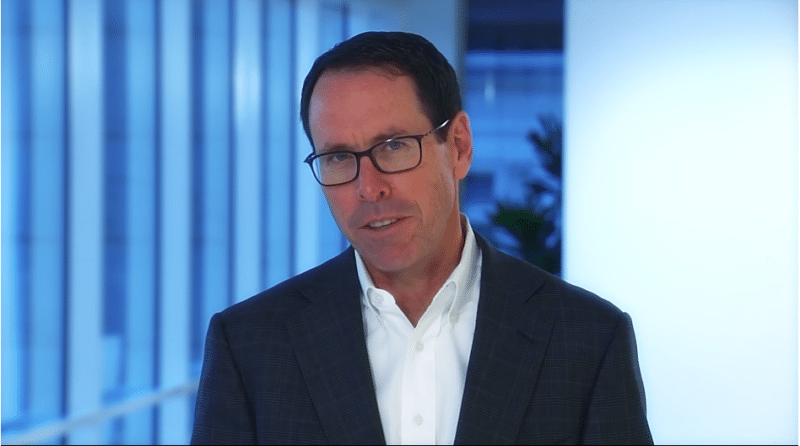Latest News

Screen capture of Randall Stephenson, chairman and CEO of AT&T, speaking during a video announcing the AT&T-Time Warner merger. Photo: AT&T
[Via Satellite 10-24-2016] Just over a year after purchasing satellite pay-TV provider DirecTV, U.S. telco AT&T is making a move to acquire media and entertainment giant Time Warner Inc., the companies announced yesterday. The total transaction value between Time Warner’s $85.4 billion in equity value and accompanying debt is $108.7 billion, following which Time Warner would constitute about 15 percent of the combined company’s revenues.
Speaking on an Oct. 24 conference call, executives from AT&T and Time Warner emphasized the ability to leverage the unique strengths of each company together to provide services consumers are demanding, namely video everywhere, ahead of competitors.
“[The Time Warner purchase] fits well in terms of our own integration plans and I also think it fits well in terms of how fast this industry is moving,” Randall Stephenson, chairman and CEO of AT&T said. “The convergence in terms of media and distribution is moving fast. We want to be at the front of it; we don’t want to be chasing it, and doing this deal now allows us to lead this type of convergence activity.”
Jeff Bewkes, chairman and CEO of Time Warner, said AT&T’s distribution capabilities would be an enormous opportunity for the company.
“We need to go where the consumers are going, and that’s increasingly mobile, increasingly multiplatform, and its increasingly on-demand,” he said.
AT&T’s total subscribers in mobile, television and broadband reached 144 million, 45 million and 26 million respectively, according to a presentation given during the call. As a single company, AT&T and Time Warner envision being able to create new customer choices, gain better customer insights across TV, mobile and broadband and provide more personalized services.
Should the merger gain regulatory approval, the impact particularly in North America could be substantial. In an Oct. 23 research note, Macquarie Capital cable, satellite and entertainment analyst Amy Yong wrote that the merger could reverberate across the media landscape.
“The one-two punch of DirecTV-Time Warner puts AT&T in a unique position to disrupt the mobile video landscape,” she wrote. “We believe their ability to address consumer demands and create catered bundles will be unmatched. The pending acquisition will force everyone to step up their game: Verizon may look to acquire other assets beyond AOL–Yahoo while Comcast/Charter could look to a wireless strategy more imminently. This could position T-Mobile, Sprint and Dish as attractive takeouts.”
Amid immediately palpable skepticism that regulators would block the deal, AT&T and Time Warner CEOs sought to assuage concerns that their companies would face challenges similar to other large media mergers in recent years. The executives described the acquisition as vertical rather than horizontal, meaning regulators should not be concerned about a loss of competition in the market as they have been with previous deals. Stephenson said the merger would likely come to fruition, but with regulatory strings attached.
“We are convinced that these types of issues can be handled with conditions,” he said.
The U.S. Department of Justice must review the merger, and AT&T and Time Warner are in the process of figuring out which Federal Communications Commission (FCC) licenses, if any, will transfer to AT&T via the transaction.
Stephenson said AT&T’s integration of DirecTV continues to generate the synergies and sales opportunities the company anticipated. Since the acquisition in July 2015, DirecTV has gained 1.2 million additional subscribers. He said the timing of the Time Warner acquisition fits well with the integration of DirecTV. AT&T and Time Warner expect their transaction to close before the end of 2017.
AT&T’s purchase of Time Warner could also influence the company’s soon to launch internet streaming service “DirecTV Now.” For the new service, AT&T is planning multiple content packages, including currently available DirecTV content, as well as premium add-on options for customers to view on internet-enabled devices. Stephenson cited the forthcoming Over-The-Top (OTT) video product as an example of where the merger would be very resourceful. DirecTV Now launches next month, and Stephenson said AT&T aspires to incorporate new abilities such as “clipping content that you’re watching and sharing it with your friends via messaging or via social media.” Customers are demanding this ability, he said, but media providers have been less than eager to enable it.
“Trying to develop those capabilities with the current content providers is proving difficult. It’s arms-length negotiation and people are obviously very protective of their content,” said Stephenson.
By teaming with content-rich partner Time Warner, Stephenson said AT&T could shed a lot of the difficulty in this process. Bewkes added that Time Warner has been trying to make Video on Demand (VOD) universal, but found that cable services and other distributors were slow to follow suite.
“If we are iterating quickly into DirecTV Now with the Time Warner content, then we begin to differentiate the DirecTV Now platform as well,” added Stephenson.
This process would be significantly faster as a single unit than as partners, Stephenson said.
Get the latest Via Satellite news!
Subscribe Now